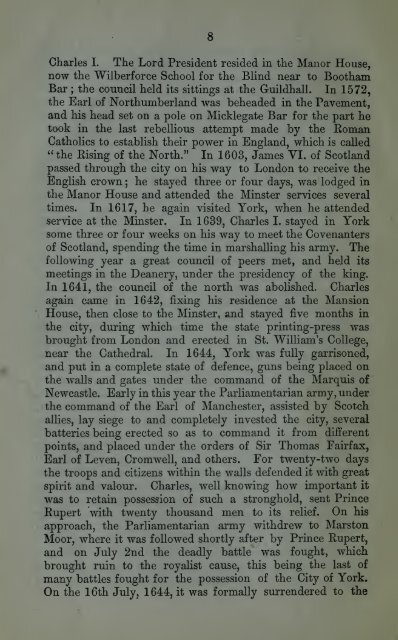practicalguideto00unse_0
You also want an ePaper? Increase the reach of your titles
YUMPU automatically turns print PDFs into web optimized ePapers that Google loves.
8<br />
Charles I. The Lord President resided in the Manor House,<br />
now the Wilberforce School for the Blind near to Bootham<br />
Bar ; the council held its sittings at the Guildhall. In 1572,<br />
the Earl of Northumberland was beheaded in the Pavement,<br />
and his head set on a pole on Micklegate Bar for the part he<br />
took in the last rebellious attempt made by the Roman<br />
Catholics to establish their power in England, which is called<br />
the Rising of the North." In 1608, James VI. of Scotland<br />
passed through the city on his way to London to receive the<br />
English crown ; he stayed three or four days, was lodged in<br />
the Manor House and attended the Minster services several<br />
times. In 1617, he again visited York, when he attended<br />
service at the Minster. In 1639, Charles I. stayed in York<br />
some three or four weeks on his way to meet the Covenanters<br />
of Scotland, spending the time in marshalling his army. The<br />
following year a great council of peers met, and held its<br />
meetings in the Deanery, under the presidency of the king.<br />
In 1641, the council of the north was abolished. Charles<br />
again came in 1642, fixing his residence at the Mansion<br />
House, then close to the Minster, and stayed five months in<br />
the city, during which time the state printing-press was<br />
brought from London and erected in St. William's College,<br />
near the Cathedral. In 1644, York was fully garrisoned,<br />
and put in a complete state of defence, guns being placed on<br />
the walls and gates under the command of the Marquis of<br />
Newcastle. Early in this year the Parliamentarian army, under<br />
the command of the Earl of Manchester, assisted by Scotch<br />
allies, lay siege to and completely invested the city, several<br />
batteries being erected so as to command it from different<br />
points, and placed under the orders of Sir Thomas Fairfax,<br />
Earl of Leven, Cromwell, and others. For twenty-two days<br />
the troops and citizens within the walls defended it with great<br />
spirit and valour. Charles, well knowing how important it<br />
was to retain possession of such a stronghold, sent Prince<br />
Rupert with twenty thousand men to its relief. On his<br />
approach, the Parliamentarian army withdrew to Marston<br />
Moor, where it was followed shortly after<br />
by Prince Rupert,<br />
and on July 2nd the deadly battle was fought, which<br />
brought ruin to the royalist cause, this being the last of<br />
many battles fought for the possession of the City of York.<br />
On the 16th July, 1644, it was formally surrendered to the















